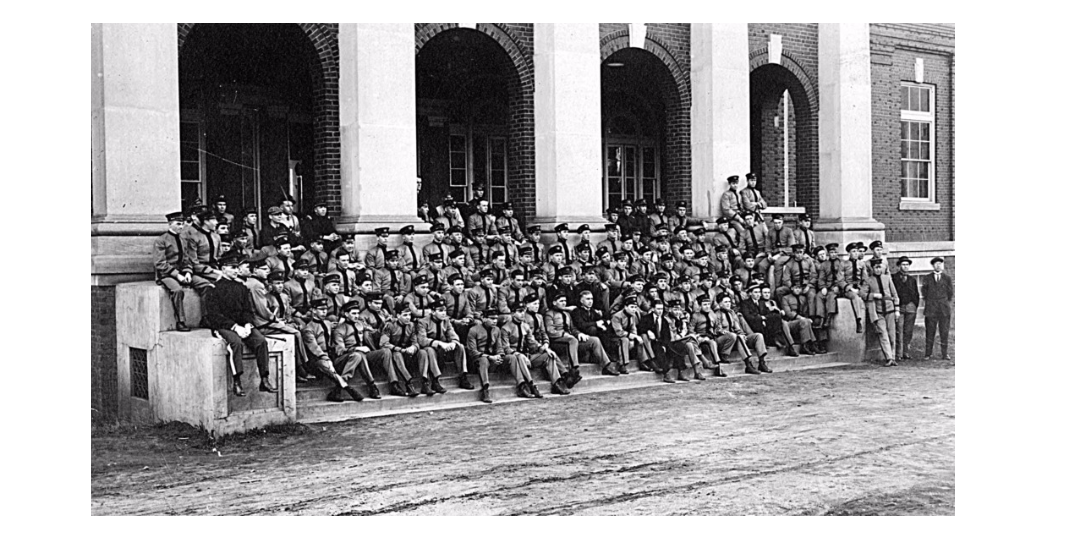
Preparing for World War I
April 6 will be the 100th anniversary of U.S. entry into World War I . By the time that the country joined the fighting, several European countries had already been at war since 1914 . For the next several months Special Collections News will occasionally look back at the impact that the war had on NC State students and faculty.
A "Peace" March
During Thanksgiving weekend in 1914, just months after the war began in Europe, a group of NC State students in their cadet uniforms marched in downtown Raleigh as part of a send-off for the football team going to an out-of-town game. A young boy saw them and asked, "Are you going to war?" "No," came the reply, "We're going to Peace," probably meaning Peace Street or Peace College (both were near a railroad station). The student publication the Red & White printed a brief account of this . Few of those students probably imagined that within three years they really could be marching off to war.
The Preparedness Campaign
Even before the U.S. entered the war, several people in the country (most prominently former President Teddy Roosevelt) advocated military preparedness. A visible aspect of Preparedness was the "Plattsburg movement ," in which "citizens' training camps" were established in various states where civilian men could enroll in five-week military-training courses (the first camp was in Plattsburg, N.Y., hence the name). By the end of 1916 thousands had volunteered to attend (a military draft did not exist until after the country entered the war). At NC State, the Red & White published articles about these camps on 30 January and 28 February 1917, and it encouraged all students to attend.
Early NC State historian David Lockmiller said that Preparedness caused little excitement on campus because students had been involved in military training since the college's earliest years in the 1890s. At that time all NC State students were required to attend drill and lectures on military science and tactics. This was a legacy of the Morrill Act that provided federal funds to land-grant colleges in all of the states. The entire NC State student body was organized into battalions and companies (by 1917 there were two battalions and eight companies), and students were required to wear cadet uniforms much of the time.
ROTC Begins
In 1916 the federal government began a reorganization of the U.S. army and the National Guard, and it created the Reserve Officers' Training Corps (ROTC) at the nation's colleges and universities. The 14 December 1916 issue of the Red & White explained how the changes would affect NC State's military program. Mandatory military service would be required only for freshmen and sophomores, who would attended drills three hours per week. Upperclassmen could elect to continue service and apply to become officers. They would also have the three-hour-per-week drill requirement plus two hours for "recitation in military science." For all students there would be a requirement to attend four-week training camps at the end of the academic year. The U.S. Army would supply all students in NC State's military program with free uniforms. Plans for the college's new ROTC program were still being worked out at the time of the 6 April 1917 war declaration.
The Mexican Border Campaign
Amidst all of the preparedness, a few NC State student saw action, of sorts, in the U.S. military before war was declared. In the summer of 1916 approximately 20 NC State students in the National Guard were stationed on the Mexican border and served into 1917. The federal government had dispatched National Guard units from around the country to supplement the regular army in border patrol after Pancho Villa's raid in Columbus, New Mexico. One student, reported on National Guard involvement in the Red & White , and it is possible he was one of the NC State students who were part of the campaign. He complained that with only a few hours of drill per day and an occasional tour of guard duty, the National Guard was being underutilized. "The present service then has rubbed the wrong way with the majority of guardsmen," he concluded. Also of note, earlier in the article he said that as many as 35 percent of those inducted had failed the physical examination. A few months later when the United States actually entered the European conflict, its troops may not have been prepared after at all for the World War.

